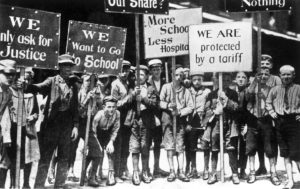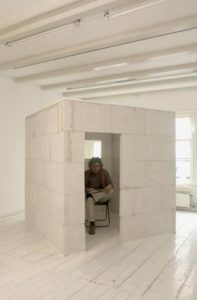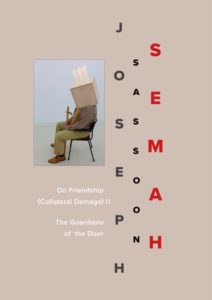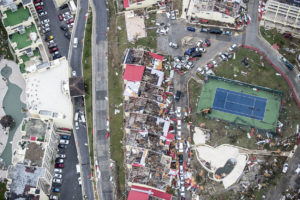Wanneer kunst religie en politiek raakt
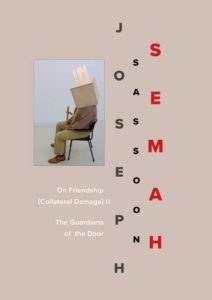 It is precisely this balance between exile and the emotion of the privileged which forms the unique originality of our ‘Breathing in Reverse’. As this will be clear already, there is no past or future in Exile, only an immediate present.
It is precisely this balance between exile and the emotion of the privileged which forms the unique originality of our ‘Breathing in Reverse’. As this will be clear already, there is no past or future in Exile, only an immediate present.
Op 21 februari 2007 was ik op uitnodiging van Joseph Semah aanwezig bij de lancering van zijn kunstproject Next Year in Jerusalem: Ein Projekt in 12 Kirchen in Niedersachsen in de Markuskirche Hannover. Hem was gevraagd in dialoog te gaan met twaalf kerkgebouwen in Niedersachsen, van Hannover tot Osnabrück, vanuit het idee dat hedendaagse kunst het geloof kan verdiepen en extra aandacht kan genereren.
“Es sind vor allem künstlerische Äußerungen gewesen, die unsere Kultur geprägt, weiterentwickelt und immer wieder auch herausgefordert haben,“ sprak de toenmalige Landesbischöfin Dr. Margot Käßmann, onder wier patronaat het kunstproject stond.
Hoe moeilijk het is echt in gesprek te gaan met de ander, bleek tijdens Joseph Semahs performance in de City Kirche St. Jacobi in Hildesheim. Tussen tweeëntwintig blauwe bergen (het aantal refereert aan de tweeëntwintig letters van het Hebreeuwse alfabet) bewogen zich, rug aan rug, een bisschop, een imam en Joseph Semah, respectievelijk citerend uit de Bijbel, de Koran en de Thora. Deze blauwe bergen hadden al eerder gefigureerd in het buitenproject HaR VeKaCh-ChOL TzILO (A Mountain and Its Blue Shadow, 1987). [i]
In Hildesheim werd het tussen de blauwe bergen een heel getrek en geduw, waarbij soms het Hebreeuwse, dan weer het Duitse of het harmonieuze Arabische gezang domineerde. En heel soms kon je in de kakofonie van de stemmen een nieuwe versie beluisteren, een fascinerend geheel. Na de indrukwekkende interventie in de kerk werd de alledaagse realiteit meteen weer zichtbaar: tot een echt gesprek tussen de bisschop en de imam wilde het niet komen. Angst voor de ander en gebrek aan kennis leek het onmogelijk te maken.
Ik heb Joseph Semah steeds beter leren kennen in dat wat hem drijft. Zijn filosofische, theologische, politiek-culturele onderzoek is verbonden aan de positie van de ander, in zijn geval de derde ballingschap: Irak, Israël en het Westen.
“De gast (in ballingschap) in onszelf is vóór alles een kunstenaar met woorden, omdat woorden het medium zijn waarmee hij zijn naam heeft leren verheimelijken, zijn twijfel verbergen, en zijn angsten verminderen door zijn eigen behoefte om te participeren in het westerse paradigma te bekritiseren.
Maar de gast in ballingschap zal altijd blijven verlangen naar de nostalgie van een verloren paradijs. De westerse kunstgeschiedenis wordt gedomineerd door de bronnen en betekenis van de christelijke erfenis. Als je je dat realiseert dan wordt het evident dat het oeuvre van kunstenaars dat onderdeel is van het westerse paradigma vanuit die erfenis wordt gelezen, getoond en geïnterpreteerd. De kunstwerken in het publieke domein zijn ‘geritualiseerd’ en verbonden met een bepaalde ‘heilige’ tekst. Dat maakt het kunstwerk gelijktijdig leesbaar maar ook schimmig en diffuus.
Door ‘versluierd’ uit deze christelijke bronnen te putten, ze onzichtbaar te maken, blijft het christendom een grote rol spelen in de maatschappelijke, culturele en politieke context. In deze context wordt het onoplosbare dilemma van de gast manifest. Enerzijds wordt hij gedwongen te zwijgen over zijn hoogstpersoonlijke wijze van ‘lezen’, anderzijds maakt hij gebruik van de westerse tactiek om opgemerkt te worden zonder te worden ontdekt.” [ii]
De ‘nieuwkomer’ voelt zich niet erkend en blijft een gast in ballingschap.
Semah gaat nadrukkelijk wel in gesprek met de ander, het meest letterlijk in zijn performances. Ook in Breathing in Reverse (Galerie Ferdinand van Dieten – d’Eendt, 23-2- 2008), waar vertegenwoordigers van de monotheïstische religies gelijktijdig voordragen uit Spinoza’s Tractatus theologico-politicus.
In de performance 72 Privileges […..]: die hij speciaal ontwikkelde voor de Kochi-Muziris Biennale, India (2012-13) gingen een boeddhist, een moslim, een Zarathustra, een hindoe, een jood, een katholiek, een humanist en de curator in dialoog, gevolgd door een artistieke interventie met tweeënzeventig kinderen.
Ook in zijn teksten en verschillende kunstwerken zoekt Joseph Semah het gesprek op: reflecties op o.a. Albrecht Dürer, Kazimir Malevich, El Lissitzky, Barnett Newman, Piet Mondriaan, Joseph Beuys, maar ook Martin Heidegger en Paul Celan. Hij verzamelt argumenten voor zijn these dat hun werk te
eenzijdig wordt geanalyseerd door de kunstwereld, namelijk vanuit een dominante christelijke invalshoek waardoor hun werk onderbelicht blijft.
Joseph Semah bestudeert en onderzoekt al meer dan dertig jaar de relatie tussen het jodendom en het christendom en de bronnen van de westerse kunst- en cultuurgeschiedenis. Een omvangrijk en interdisciplinair onderzoek, waarbij hij kunst met andere terreinen, religie, politiek, filosofie, wetenschap, in contact brengt. Met de resultaten uit dit onderzoek brengt Semah ‘correcties’ aan op de geschiedschrijving van de kunstgeschiedenis, filosofie en de theologie.
In het project The Wandering Jew / The Wondering Christian (Universiteit Leiden, LAK Gallery 1998) staan de misverstanden in de relatie jodendom en het christendom centraal, met name in de reformistische periode die geen ruimte bood voor andere geloven dan het christelijke. Semah benadrukt de zwarte, destructieve kant van Maarten Luther, die andersgelovigen (joden) uitsloot.
Het embleem van de haas in de westerse iconografie gebruikt Semah als illustratie van het ‘misverstand’ tussen het jodendom en christendom, waarbij de jood wordt gesymboliseerd door de haas (een symbool dat veelvuldig is gebruikt door Hitler).
Luthers gedrukte teksten werden ruim verspreid in Europa. Hij schreef vlak voor zijn dood heftige, antisemitische pamfletten: in 1543 verscheen Von den Juden und ihren Lügen, dat in zijn tijd, maar ook voor Hitler een bron van inspiratie was. Ook nu nog speelt de haas een belangrijk rol in met name de Duitse cultuur: in het werk van b.v. Joseph Beuys, het meest pregnant in zijn ‘Aktion’ uit 1965 Wie man dem toten Hasen die Bilder erklärt.
In het project On Friendship / (Collateral Damage) II – The Guardians of the Door (2017) zijn de viering van 500 jaar reformatie en Maarten Luther het beginpunt. Joseph Semah gaat opnieuw in gesprek met Luther maar ook andere denkers, kunstenaars en religieuze vertegenwoordigers worden uitgenodigd te participeren in rondetafelgesprekken, installaties en performances en tentoonstellingen. De gelijknamige publicatie werd op 20 oktober 2017 in het Stedelijk Museum, Amsterdam gepresenteerd. [iii]
De hoofdlocatie is De Nieuwe Kerk in Amsterdam, waar in 1948 de oprichtingsvergadering van de Wereldraad van Kerken plaatsvond. Doel was alle christelijke kerken te verenigen, maar zo vlak na de Tweede Wereldoorlog stond vanzelfsprekend ook het antisemitisme binnen het christendom hoog op de agenda. Joseph Semah is gevraagd artistiek te reflecteren op 500 jaar reformatie en Luther.
Joseph Semah is geen onbekende van De Nieuwe Kerk: in 1991 participeerde hij in de tentoonstelling FUENTE (met o.a. Marina Abramovic, Bill Viola en Daniel Libeskind, 1991) en meer recent in de tentoonstelling Jodendom. Een wereld vol verhalen (2011).
In FUENTE herschikt Semah in zijn installatie Correction IV (ijzer, schapenhersenen in brons gegoten, 200 cm hoog, diameter 300, in vier delen) de plattegrond van De Nieuwe Kerk (voor Semah een representatie van de schedel van een slang, zoals men kan zien in diverse plattegronden van Gotische kerken) door de vier pilaren, die het centrum van de kerk markeren, te voorzien van een bronzen omhulsel, waardoor de kruisvorm van de kerk wordt gecorrigeerd en opnieuw betekenis krijgt.
In de tentoonstelling Jodendom. Een wereld vol verhalen wordt zijn serie An introduction to the principle of relative expression (1979, oliekrijt op Talmud Bavely, Tractate PeSaChIM) prominent getoond tegenover de legendarische Dode Zee-rol. Semah refereert expliciet aan de joodse cultuur, traditie en identiteit die van oudsher wordt gekenmerkt door het becommentariëren, vragen en bevragen, reflecteren, interpreteren en analyseren. Hij ging in gesprek met een van de oudste heilige geschriften.
Voor On Friendschip / (Collateral Damage) II – The Guardians of the Door in De Nieuwe Kerk ontwikkelde Joseph Semah een installatie die middels een bijzondere performance werd voltooid.
Het resultaat is een drieëndertig meter lange tafel ondersteund door schragen waarop 95 eieren met 5000 meter witte draden. De tafel verwijst naar de vele meters lange meterlange tafel die in de kerk stond bij de oprichtingsvergadering van de Wereldraad van Kerken.
De witte draden zijn een symbolische verwijzing naar de omtrek van de stadsmuren van Jerusalem van boven en Jerusalem van beneden (het goddelijke en het aardse). Het aantal eieren refereert aan de 95 stellingen die Maarten Luther op de kerkdeur van Wittenberg zou hebben getimmerd.
Door de plaatsing van de tafel herschikt Semah opnieuw het grondplan van De Nieuwe Kerk en voegt de joodse betekenislaag toe in het hart van de kerk.
Joseph Semah bestempelen als een ‘joodse’ kunstenaar doet hem tekort. Semah, geboren in Bagdad, opgegroeid in Israël, kwam in 1975 in het Westen in aanraking met een cultuur die voor hem vreemd was. Door te ‘lezen’ in zijn moedertaal, het Hebreeuws, signaleert hij een gebrek aan joodse kennis en een gebrek aan aandacht in de joodse betekenislaag. Hij voelt de urgentie ook deze informatie toe te voegen en vult de ‘lege pagina’ met de verloren joodse elementen in de kunst- en cultuurgeschiedenis.
Semah signaleert niet alleen een misverstand in de representatie tussen het jodendom en christendom, een manier waarop kunst verbeeldt, maar ook dat kunst kan worden ingezet voor politieke en religieuze doeleinden. In zijn essay Over vriendschap (Bijschade) overtuigt hij de lezer met zijn analyse dat de CIA in het geheim naoorlogse Amerikaanse abstracte doeken gebruikt heeft als onderdeel van zijn activiteiten in de Koude Oorlog en tevens die naoorlogse abstracte doeken, nagenoeg verborgen voor de meeste betrokken kunstenaars, naar het centrum van de belangstelling heeft geschoven “als een soort strategische vloerbedekking, om op die manier als het ware de vernielde bodem van het naoorlogse Europe toe te dekken.” [iv]
Met zijn performances, kunstwerken en teksten levert Joseph Semah een bijdrage aan het internationale, inclusieve kunst- en cultuurdiscours. Hij kijkt kritisch hoe de westerse kunst en cultuur worden gepresenteerd, en waarom. Hij voegt bronnen en tradities uit andere culturen toe en gaat op zoek naar nieuwe ordeningen, een andere conceptuele blik die meer overeenkomt met de realiteit van een pluriforme samenleving. Joseph Semah levert correcties en/of aanvullingen op theologische en politieke teksten, filosofische bespiegelingen en op bestaande kunsthistorische of theoretische beschouwingen. Hij pleit naar aanleiding van zijn onderzoek en de daaraan verbonden conclusies dat in de kunstgeschiedenis een belangrijkere en grotere plaats wordt ingeruimd voor verschillende bronnen en informatie, om zo een breder draagvlak voor andere visies te creëren.
Noten
[i] Ze stonden opgesteld naast ARMON HaNaTzIV (het vroegere hoofdkwartier van de Britse high commissioner, 1933), op de ‘groene’ grenslijn tussen Israël en Jordanië (Armistice Lines, vanaf 1949 tot de Zesdaagse Oorlog 1967). De Palestijns-Amerikaanse literatuurwetenschapper en voorvechter van de Palestijnse zaak Edward Said vertelde Joseph Semah dat de blauwe bergen, kort na plaatsing op bevel van de Palestijnse leider Yasser Arafat, werden vernietigd. Weer later werd Joseph Semah door de gemeente van Jerusalem gevraagd de blauwe bergen te herplaatsen, hetgeen hij heeft geweigerd.
[ii] Fragment uit Het antwoord is dit – Joseph Semah.
[iii] In 2015 resulteerden dit onderzoek en de bevindingen in het artistiek-filosofische project en het gelijknamige boek On Friendship / (Collateral Damage), red. Linda Bouws en Joseph Semah, Stichting Metropool Internationale Kustprojecten, 2015, waarin Semah, maar ook derden een analyse maken van de voorlopige conclusie van deze uitgebreide verkenning. De vraag staat centraal in hoeverre aan de joodse en christelijke invloeden aandacht wordt besteed in de westerse kunst- en cultuurgeschiedenis en waarom de joodse betekenislaag, bewust of onbewust, onderbelicht is. En ook wordt de vraag gesteld waarom steeds vaker wordt gesproken over de joods-christelijke erfenis van Europa, een definitie die niet terecht is gezien de ontbrekende joodse pagina.
[iv] Zie On Friendship/ (Collateral Damage), redactie Linda Bouws en Joseph Semah, p. 75, Stichting Metropool Internationale Kunstprojecten, Amsterdam.
